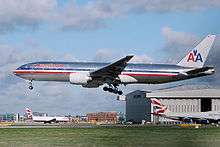Mainline (aeronautics)


_Boston.jpg)
A mainline flight is a flight operated by an airline's main operating unit, rather than by regional alliances, regional code-shares or regional subsidiaries.
In the United States, examples of mainline passenger airline flights include those operated by American Airlines, Delta Air Lines, United Airlines, and now defunct US Airways; but not flights operated by regional airlines Envoy Air, Executive Airlines, Piedmont Airlines, or PSA Airlines with regional jets or the services of regional airline marketing brands such as American Eagle, Delta Connection, United Express, or US Airways Express aboard lower-capacity narrowbody jets and turboprop aircraft, such as those produced by Embraer or Bombardier, that do not have transcontinental range.
U.S. legacy carriers may operate branded mainline services using the same flight crews and AOC as that of their mainline operations. For example, United p.s. and American Flagship Service cater to the medium-haul transcontinental business segment. Short-haul air shuttles, such as Delta Shuttle, operate at high frequency intervals between busy city pairs. Previously, U.S. legacy carriers operated low-cost air services within their mainline operations to compete with low-cost carriers; these operations were short-lived and included brands such as Continental Lite, Song (Delta), and Ted (United).
An airline carrier's collective bargaining agreement with flight crews stipulates the maximum seating capacity of regional aircraft; as such, any aircraft that exceeds this capacity must operate as a mainline flight. The converse is not the case; mainline flight crews, with proper type ratings, may operate aircraft that are smaller than typical mainline aircraft.
Major U.S. Mainline Carriers
| Airline | Regional subsidiaries1 | Regional brand2 |
|---|---|---|
| Legacy carriers | ||
| American Airlines | Envoy Air PSA Airlines Piedmont Airlines |
American Eagle |
| Delta Air Lines | Endeavor Air | Delta Connection |
| United Airlines | No regional subsidiary | United Express |
| Alaska Airlines | Horizon Air | Alaska Horizon Alaska SkyWest |
| Hawaiian Airlines | No regional subsidiary | Ohana by Hawaiian |
| Low-cost carriers | ||
| Allegiant Airlines | No regional subsidiary | No regional brand |
| Frontier Airlines | No regional subsidiary | Great Lakes Aviation3 |
| JetBlue Airways | No regional subsidiary | Cape Air3 |
| Southwest Airlines | No regional subsidiary | No regional brand |
| Spirit Airlines | No regional subsidiary | No regional brand |
| Sun Country Airlines | No regional subsidiary | No regional brand |
| Virgin America | No regional subsidiary | No regional brand |
Notes:
1 Wholly owned subsidiaries with separate operating certificates flying regional jets under the regional branding.
2 Branding used for regional feeder service and commuter flights. Operated either by a regional subsidiary or under contract by an independent regional airline.
3 These independent airlines operate regional aircraft under codeshare agreements with a mainline carrier.